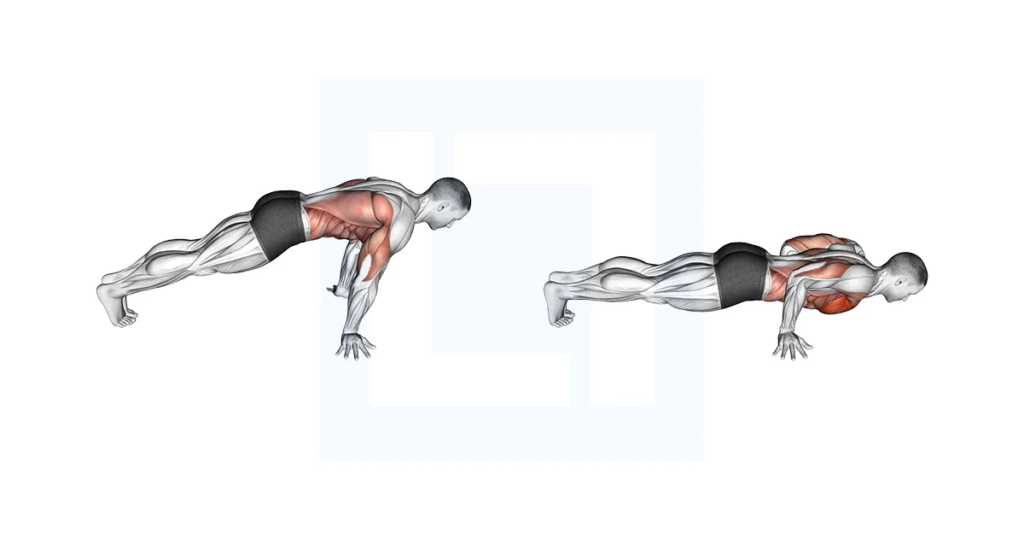When it comes to building a strong and defined chest, many people think they need a gym full of equipment or a set of heavy weights. However, that’s not necessarily true. You can develop an impressive chest using just your bodyweight, making it possible to do effective chest exercises at home without any equipment. Whether you’re a beginner, don’t have access to a gym, or simply want to mix up your workout routine, these chest exercises will help you build strength and muscle.
Why Train Your Chest Without Equipment?
Bodyweight exercises offer several benefits, even for those who typically use weights. Training without equipment:
- Increases functional strength: These exercises mimic natural movements and help improve overall body control and coordination.
- Improves stability: Bodyweight exercises engage your core and stabilizer muscles, leading to greater balance and stability.
- Can be done anywhere: With no equipment required, you can do these exercises at home, in a park, or even in your hotel room when traveling.
- Reduces the risk of injury: Since you’re not lifting heavy weights, bodyweight exercises can be gentler on your joints while still building muscle and strength.
Let’s explore some of the most effective chest exercises without equipment.
1. Push-Ups – The Ultimate Bodyweight Chest Exercise

Push-ups are the cornerstone of bodyweight training. They primarily target the chest, but they also engage your shoulders, triceps, and core, making it a full-body workout. The beauty of push-ups is that you can modify them based on your fitness level, making them suitable for beginners and advanced athletes alike.
How to Perform a Basic Push-Up:
- Start in a high plank position with your hands placed slightly wider than shoulder-width apart.
- Keep your body in a straight line from head to heels, engaging your core.
- Lower your body toward the floor by bending your elbows, making sure your elbows are at a 45-degree angle from your body.
- Push yourself back up to the starting position by extending your arms.
Variations:
- Knee Push-Up: For beginners, keep your knees on the ground to reduce the difficulty.
- Wide-Grip Push-Up: Place your hands wider apart to emphasize the chest muscles more.
- Narrow-Grip (Diamond) Push-Up: Place your hands close together in a diamond shape under your chest to target the triceps along with the chest.
Why It Works:
Push-ups are versatile and effective because they can be done anywhere and can be modified to suit any fitness level. The wide range of push-up variations ensures that you can continually challenge your muscles as you get stronger.
2. Incline Push-Ups – Focus on the Lower Chest

Incline push-ups are a great variation that shifts the focus to your lower chest muscles. Since you’re pushing your body at an incline, this exercise is easier than a standard push-up, making it perfect for beginners or as a warm-up for more advanced athletes.
How to Perform Incline Push-Ups:
- Find a sturdy surface like a bench, step, or even the edge of your couch.
- Place your hands on the surface, slightly wider than shoulder-width apart.
- Lower your body toward the surface by bending your elbows.
- Push your body back up to the starting position.
Why It Works:
Incline push-ups reduce the amount of weight you’re pushing, making them easier to perform. They focus more on the lower chest while still working your shoulders and triceps.
3. Decline Push-Ups – Hit the Upper Chest

Decline push-ups are the opposite of incline push-ups. By elevating your feet, you place more emphasis on your upper chest and shoulders. This variation is more challenging than a regular push-up, making it ideal for those who want to add intensity to their workout.
How to Perform Decline Push-Ups:
- Elevate your feet on a stable surface like a bench, chair, or step.
- Position your hands on the floor, slightly wider than shoulder-width apart.
- Lower your body toward the ground by bending your elbows.
- Push your body back up to the starting position.
Why It Works:
Decline push-ups place more emphasis on your upper chest muscles, which can often be underdeveloped compared to the middle and lower chest. They also increase the difficulty of the exercise by shifting more of your body weight onto your arms.
4. Plyometric (Clap) Push-Ups – Build Explosive Power

Plyometric push-ups, often referred to as clap push-ups, are an advanced variation that involves pushing your body off the ground with enough force to clap your hands together. This explosive movement builds power in your chest, shoulders, and triceps, as well as increasing fast-twitch muscle fiber activation.
How to Perform Plyometric Push-Ups:
- Start in a standard push-up position.
- Lower your body toward the floor as you would in a normal push-up.
- Push up explosively, lifting your hands off the floor and clapping them together before catching yourself back in the push-up position.
Why It Works:
The explosive nature of plyometric push-ups helps build fast-twitch muscle fibers, which are crucial for strength and power. This exercise is also great for improving cardiovascular fitness and stamina.
5. Chest Dips (Using Furniture) – Target the Lower Chest

Although chest dips are traditionally performed on parallel bars, you can still do this exercise at home using sturdy furniture like chairs or a countertop. Dips are one of the best chest exercises for targeting the lower chest and triceps.
How to Perform Chest Dips:
- Place your hands on the edge of two sturdy surfaces like chairs, spaced shoulder-width apart.
- Lower your body by bending your elbows, making sure your torso leans slightly forward.
- Push your body back up to the starting position.
Why It Works:
Chest dips specifically target the lower chest while also working your triceps and shoulders. Leaning forward during the movement increases chest activation.
6. Wide-Arm Push-Ups – Engage More Chest Muscles

Widening your grip during a push-up places more focus on the chest muscles, particularly the pectoralis major. Wide-arm push-ups are a simple yet effective way to increase chest muscle activation without equipment.
How to Perform Wide-Arm Push-Ups:
- Start in a push-up position with your hands placed wider than shoulder-width apart.
- Lower your chest toward the floor, keeping your elbows at a 45-degree angle.
- Push your body back up to the starting position.
Why It Works:
By increasing the distance between your hands, wide-arm push-ups place more stress on the chest muscles. This variation is particularly useful for building the outer chest and adding definition.
7. Wall Push-Ups – Perfect for Beginners

Wall push-ups are an excellent starting point for those new to exercise or recovering from an injury. This exercise reduces the amount of body weight you’re lifting, making it ideal for beginners to build strength before progressing to more challenging variations.
How to Perform Wall Push-Ups:
- Stand a few feet away from a wall with your hands placed on the wall at chest height.
- Keep your body in a straight line as you bend your elbows and lean toward the wall.
- Push yourself back to the starting position.
Why It Works:
Wall push-ups are a gentle introduction to bodyweight training and help beginners build strength and confidence. As you get stronger, you can gradually progress to incline push-ups and eventually standard push-ups.
8. Plank-to-Push-Up – Combine Core and Chest Strength

The plank-to-push-up combines two effective bodyweight exercises into one, engaging your chest, shoulders, triceps, and core all at once. This dynamic movement is excellent for building overall upper body strength and improving stability.
How to Perform Plank-to-Push-Up:
- Start in a forearm plank position with your elbows directly under your shoulders.
- Push up onto your hands, one arm at a time, into a high plank (push-up) position.
- Lower back down onto your forearms, one arm at a time, to return to the plank position.
Why It Works:
This exercise not only builds chest strength but also challenges your core and shoulder stability. It’s an efficient way to engage multiple muscle groups in one movement.
9. Pseudo Planche Push-Ups – Advanced Chest and Shoulder Builder

For those looking for a real challenge, pseudo planche push-ups shift your bodyweight forward, increasing the load on your chest and shoulders. This advanced exercise mimics the planche position used in gymnastics and requires significant upper body strength.
How to Perform Pseudo Planche Push-Ups:
- Start in a regular push-up position, but place your hands lower, near your waistline.
- Lean your body forward, shifting more of your weight onto your hands.
- Perform a push-up by lowering your chest toward the ground, then push back up.
Why It Works:
Pseudo planche push-ups are highly challenging because they shift more weight onto your upper body. They engage your chest, shoulders, and triceps intensely, making this exercise ideal for advanced trainees.
Structuring Your Equipment-Free Chest Workout
Now that you know some of the best chest exercises without equipment, here’s how you can structure your workout:
- Warm-Up: 5-10 minutes of light cardio (jogging in place, jumping jacks) and dynamic stretching.
- Workout: Choose 4-5 exercises from the list and perform 3 sets of 10-15 reps for each. For advanced exercises like plyometric push-ups or pseudo planche push-ups, aim for fewer reps with good form.
- Cool Down: Stretch your chest, shoulders, and triceps for 5-10 minutes to enhance recovery.

